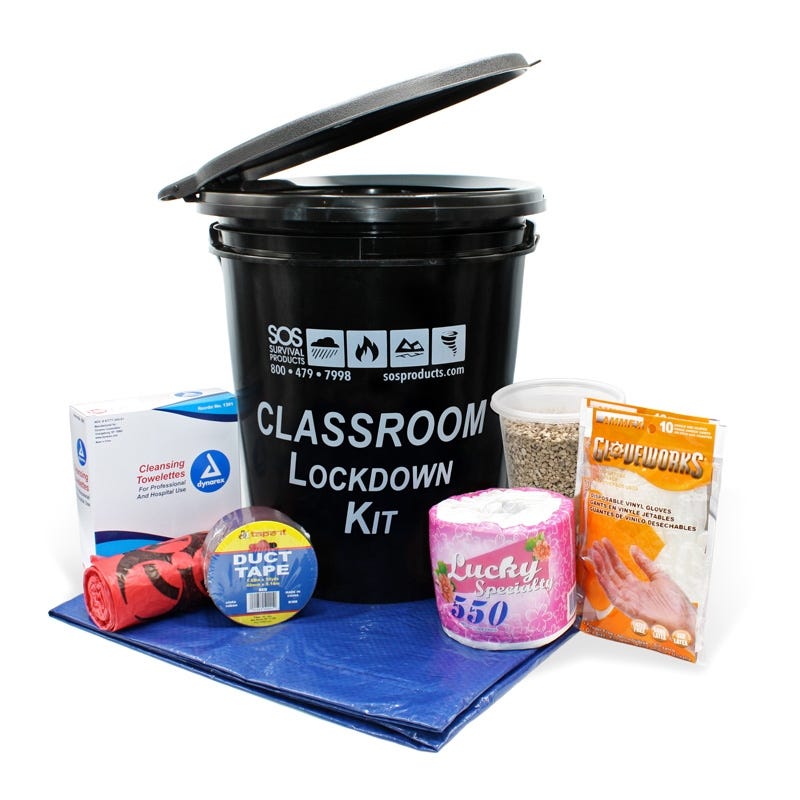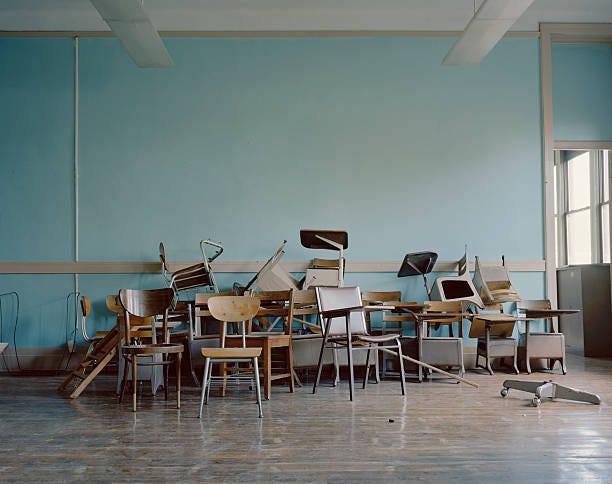“Being a Teacher in America Means Being Willing to Take a Bullet For Your Kids”
Teachers talk about what it's like to hold the lives of students in their hands—and the toll the threat of violence is taking on everyone in the classroom
As the country reels from this week’s elementary school massacre in Uvalde, Texas, calls for action—any action—are being met with the reality that teachers and students are still on their own.
Nineteen children and two teachers were killed by the shooter. But no legislative compromise or sweeping reform is coming. There’s no quick fix.
That leaves teachers in charge of student safety, expected to walk students through drills to prepare them for attacks, handle classrooms of terrified children during lockdowns, and, if necessary, protect the kids with their lives.
I asked teachers in districts around the country what that responsibility is like. Here’s what they told me (in the interest of protecting anonymity, pseudonyms have been used).
Drills
Students have to go through shooter drills to prepare them for if and when a shooter enters the school. The exercises are seen as something like fire drills by students, teachers I spoke to told me, a normalized part of their school life.
Joshua, a 26-year-old former teacher from Florida who worked in schools from 2019 to 2021, told me that the disruption from the drills would continue for the school day.
“You'd hear things here and there for the rest of the day,” Joshua said. “Fire drills usually only disrupted one class but the vibe was off for the rest of the day on shooter drills.”
Little wonder why. The video Dan, a 35-year-old teacher in Southern California, has to play for students shows the stakes of being in an active shooter situation. The reminder of imminent death is traumatizing.
“If they’re in a room they’re supposed to stay in the room,” Dan told me. “My specific classroom is located on the edge of campus, so when the video is done I tell my kids if they want to stay in the room they can, I kind of have to, but if they want to make a run for it, they can try to get across the street and just bang on peoples doors until someone lets them in their house.”
If they’re trapped outside, students are told to “run, hide, or fight.” The run, hide, fight plan is standard; it can also go by ADD, “avoid, deny, defend.”
Students are told what to do if they’re in danger, while teachers have a set of instructions for the classroom. Samuel, a 28-year-old teacher at a small private school in Alpharetta, Georgia, told me that he’s expected to keep students away from windows, lock the door with a special magnetic strip, and put up a laminated piece of paper over the door’s window.
The psychological toll of hiding while simultaneously preparing to fight for your life is intense at any age, but for kids it’s even worse. Children still have developing brains, even in high school, and the relentless fear and trauma from preparing for death—even if it is, as Samuel says, as fatalistic as the “duck and cover” drills of the Cold War—is wearing.
“Kids don't deserve to grow up scared like that,” Samuel said.
Lockdown
In an actual lockdown, teachers have to manage their classrooms for hours without anyone having the ability to leave. In theory, this situation would be facilitated by efficient school strategies and cooperative students. In practice, of course, it’s anything but; classrooms aren’t meant to be living quarters.
John, a 37-year-old teacher in Texas, works at a school that endured a lockdown for a violent threat four years ago. Students were stuck inside the room for over five hours as authorities combed over the campus and looked for any possible threats. John and his fellow teachers had to set up in-classroom bathroom facilities for students and teachers alike as they waited out the sweep.
“We were pissing in trash cans in class,” John said. “It was awful.”
Awful, yes. But not outside the norm. A number of teachers I spoke to told me that their classrooms are equipped with “go-buckets,” five-gallon buckets with the sole purpose of being used as the classroom toilet during lockdowns. In some cases, there’s a privacy screen, but the basic functionality of pissing and shitting in a bucket a few feet away from the rest of the class remains.
“I don’t look at it as a humiliation,” Dan, the Southern California teacher, said. “Just a really fucked up sign of the times.”
Fallout
The constant reminder of violence is draining on students and teachers alike. A relentless drumbeat of death echoes through school hallways around the country, and it’s having a deleterious effect on the mental health and outlook of everyone on campus.
For students, that’s meant increasing apathy and anger at a system that refuses to prioritize their safety. Two years—and counting—of Covid hasn’t helped. Today’s kids are in a constant state of chaotic lockdowns, never knowing if they have to quarantine or shelter in place. Ashley, a 37-year-old education professional in San Diego who is working through a Teacher Ed program, told me that the net result has been a desensitized population.
“It just is part of our routine, like earthquake and fire drills,” Ashley said. “I didn’t grow up like this, and it’s really demoralizing to see so many little kids just rolling with it now because they don’t know any different.”
There’s not a lot of hope that anything will change, said Omar, a 28-year-old teacher in central Massachusetts. Students have largely given up on a better future for school shootings, calling the prospect of government action to address the issue “not realistic.”
“They seem totally apathetic and nihilistic about the lack of a functioning government response,” Omar told me.
“You can’t stop the storm”
Meanwhile, teachers are feeling expendable and disposable. That’s not new—they aren’t paid enough, aren’t treated with respect, and are subject to mistreatment on a number of levels—but the shooting drills really hammer the point home.
“Being a teacher in America means being willing to fight a gunman with a chair or your bare hands,” Jane, a 35-year-old teacher in upstate New York, said. “Being a teacher in America means being willing to take a bullet for your kids.”
Joshua, the former teacher from Florida, recalled that it was never in doubt that if there was an active shooter on campus, he was expected to die in the classroom. The poor treatment he endured as a teacher combined with the threat of being killed was too much.
“You look around wondering whether you're valued and the answer is no,” Joshua said. “You're a sandbag in a hurricane. You can't stop the storm but you're expected to drown in it.”
It’s just not fair to put the burden of school shootings on the likely victims, Amanda, a 27-year-old teacher in Ohio who is leaving the profession this year, told me. That’s been the move for years, and, as she pointed out, it’s changed next to nothing.
“Why are we putting the responsibility on teachers and kids?” Amanda asked. “Haven’t we been doing all this for years?”
“It doesn’t help or change anything, clearly,” she added. “Or you and I wouldn’t be having this conversation.”
If you would like to support my work, please consider a paid subscription
Find me on Twitter and Facebook
Email me at eoinhiggins@gmail.com








In the world
In praise of all educators the world.
Not all of them wear Kevlar blouses but if that’s what it takes to avoid lead or a shiv maybe make a Patagonia or MacPac street wear version of that type of PPE .